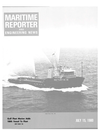
Page 14: of Maritime Reporter Magazine (July 15, 1980)
Read this page in Pdf, Flash or Html5 edition of July 15, 1980 Maritime Reporter Magazine
A Combined Pipeline/Marine Transportation System
Canada's Arctic Pilot Project
Dawson R. Miller*
The Canadian Arctic Pilot Pro- ject is a combined pipeline/mar- ine transportation system for Arc- tic natural gas to supply about 7.0 million cubic meters of gas per day to southern consumers. After a three-year development period, we are now very close to initiating the construction of various com- ponents within the project.
Generally these are: the gas gathering system at the gas field; a gas pipeline across the Island to Bridport Inlet adjacent to Vis- count Melville Sound; the facili- ties at Bridport Inlet which in- clude the gas liquefaction (or process) barge, the storage barg- es and the vessel loading equip- ment; the two ships which will bring the liquid gas from the
Arctic to the southern terminal, and the southern regasification facilities.
The gas that will be used is lo- cated in the Drake Field discover- ed by Panarctic on the Sabine
Penninsula on Melville Island, which is located in the Parry Is- lands of the Canadian Arctic arch- ipelago. This gas is excellent gas which requires very little pre- treatment before being pipelined.
The methane content is very high —about 98 percent. Initially, eight wells will be drilled to supply the 8 million cubic meters per day required production with addition- al drilling being continued to maintain the production rate.
After chilled glycol treatment to remove water and to cool the gas to below the freezing point, the gas will be supplied to the cross-island pipeline.
The complete route of this pipe- line is in permafrost so Alberta
Gas Trunkline (AGT), who are the managers of that component, have chosen to use a buried chilled gas pipeline. The cold gas will not degrade the permafrost and *Mr. Miller, naval architect for Petro-
Canada with particular responsibility for the Arctic Pilot Project, presented the paper condensed here before the recent Canadian Shipbuilding and
Ship Repairing Association's Annual
Meeting. by burying will be isolated from the 40-cm deep active or growing area. During 1979, AGT conduct- ed tests at Rae Point to identify the proper procedures for back filling the trench to avoid slump- ing, etc. The overland distance of the pipeline is about 160 kilome- ters and its diameter about 560 mm. This pipeline initially will not have any active compression since the gas comes from the field at about 8,500 kPa. As the field pressure drops due to depletion, compressions will be added to maintain the throughput.
At Bridport Inlet, the gas will be supplied to the process barge, where heat will be extracted from the gas stream by means of a multi-component refrigerant cy- cle. The gas will be cooled to about — 162°C at which point it becomes a liquid at atmospheric pressure.
This plant will be constructed in- tegral to a barge hull to allow building in an existing shipyard and then towed by way of Baffin
Bay and Lancaster Sound to Brid- port Inlet. The beam of the barge has been set to allow pass- age through the Panama Canal.
The output from the lique- faction process, about 12,200 cu- bic meters of liquid per day will then be transferred to two storage barges for holding until ready for loading onto the ships. These two storage barges will be designed so that they could be built in a
Canadian shipyard.
The liquid gas will be loaded onto either of two large icebreak- ing carriers for transportation to the south. Each ship will be about 375 meters long overall with a beam of 42 meters and a draft of 11 meters in open water and 13 meters in ice. Displacement will be about 140,000 tons. The propulsion system will be ac/ac electric with three 44 MW electric propulsion motors, each driving an 8-meter- diameter fixed-pitch propeller.
The number of gas-turbine/elec- tric generators will depend on the final choice of prime move and its power level. Candidate units in- clude the LM 2500, the RB211 and the FT4, all gas turbines of the aero-derived type. These tur- bines will be fueled by a portion of the natural gas cargo; by aug- menting the natural boil-off for the heavier load conditions. The use of the very clean natural gas is expected to reduce the main- tenance costs and times signifi- cantly on the gas generator and power turbine over liquid fuel.
The other big plus factor is the security of supply of the fuel since our company analysts be- lieve that the availability of liquid fuel cannot be guaranteed in the 1990s and after.
The 140,000 cubic meters of liquid cargo will be carried in five tanks in the vessel. At present the system for cargo containment has not been finalized—either the membrane or spherical tanks will be acceptable. The final choice may well be made based on the li- censing arrangements which the shipyard has prepared.
Because of their size and com- plexity, it is unlikely that the ships will be built in Canada, al- though two shipyards are working on a method by which they will participate in a joint venture with an offshore yard.
The locality of the southern terminal is not yet fixed. Three sites are presently under consider- ation—Gros Cacouna, P.Q.; Saint
John, N.B., and Strait of Canso,
N.S. The final choice of the site will probably be dictated by ex- ternal factors.
The process of liquefying the gas stream is quite simple in prin- ciple. It involves removing enough heat from the incoming stream so that its temperature is reduced to about — 162°C. The process chos- en will be that marketed by Tech- nip of France. Most of this heat exchange process takes place in- side the cryogenic heat exchanger which will be the largest single item of equipment on the barge.
This unit will receive about 7,800,- 000 cubic meters of gas per day and produce about 12,570 cubic meters of LNG at full design capacity.
Refrigeration for the liquefac- tion process will be supplied by three Elliot compressors absorb- ing a total of 61 MW, and being direct driven by a Cooper power turbine driven by a Rolls-Royce
RB211 gas generator unit. Inlet air for these power units will be drawn through a marine type air filter and silencing system to re- move salt and moisture. In cer- tain conditions this inlet air will require preheating to avoid ice build-up.
Boil-off gas and process flash gas will be recompressed for use as fuel by a 3-MW compressor which may be electric or gas-tur- bine driven.
Electrical service power will be provided by two gas-turbine-pow- ered generator sets, each at about 10 MW. All these gas-turbine units will be fired on natural gas.
The barge hull itself will be about 132 meters by 32.3 meters by 15.6 meters with a full length "industrial" building type super- structure. The hull will have a complete double skin and will be strengthened to allow for being frozen into an intact ice sheet.
Because the barge will not be drydocked for at least 20 years, some special features will be in- cluded in the specification. Some of these features are: access must be allowed to all the inside sur- faces of the shell; there will be a high adhesion outside coating system; there will be an impressed current system for corrosion pro- tection ; arrangements must be made to allow the maintenance of ship side valves while afloat, and a system of identification marks placed on the outside of the shell plating to allow divers to orient themselves.
The plant to be installed on this barge is very complex and, of course, includes a considerable amount of cryogenic piping and fluid handling equipment. A typi- cal material for this service would be stainless steel, and due to the flammable nature of the fluid, the highest standards of design and assembly procedures must be used 16 ZIDELL Maritime Reporter/Engineering News

 13
13

 15
15
